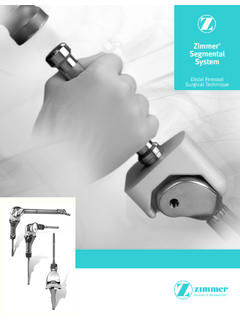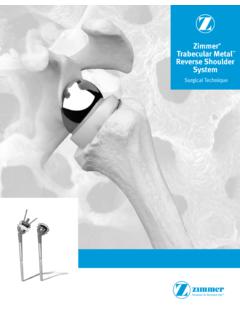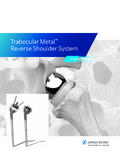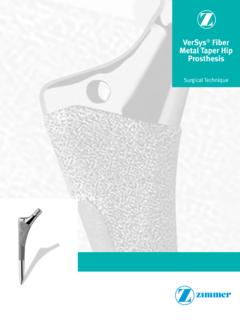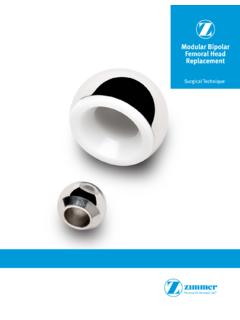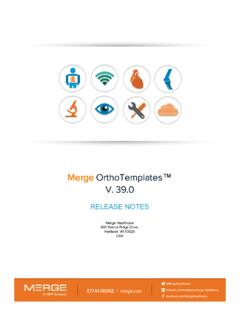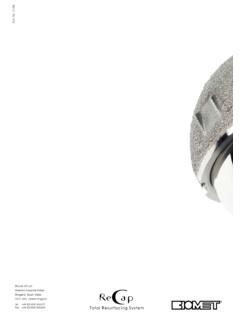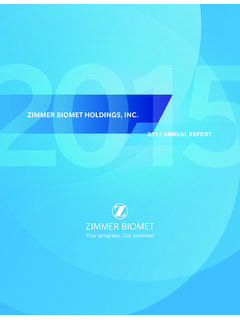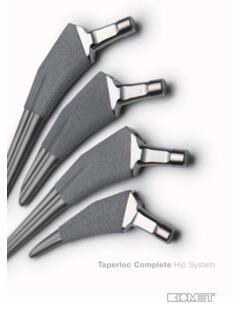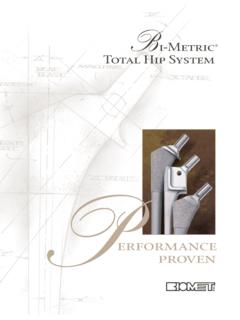Transcription of Zimmer Hip Prosthesis
1 Zimmer . M/L Taper Hip Prosthesis Surgical Technique Zimmer M/L Taper Hip Prosthesis 1. Zimmer M/L Taper Table of Contents Hip Prosthesis Surgical Technique Preoperative Planning 2. Determination of Leg Length 2. Determination of Abductor Muscle Tension and Femoral Offset 2. Component Size Selection/Templating 3. Surgical Technique 5. Exposure 5. Determination of Leg Length 5. Osteotomy of the Femoral Neck 5. Preparation of the Femur 6. Femoral Rasping 7. Rasp Options 7. Differentiating Between system and 0mm Rasp 7. Torque the Rasp (Optional) 7. Calcar Planing (Optional) 7. Trial Reduction 8. Insertion of the Femoral Component 8. Optional Insertion Technique 9. Femoral Component Extraction 9. Attachment of the Femoral Head 9. Wound Closure 9. Postoperative Management 9. Zimmer M/L Taper Hip Prosthesis Dimensions 10. Zimmer M/L Taper Hip Prosthesis Instrumentation 12. 2 Zimmer M/L Taper Hip Prosthesis Preoperative Planning Determination of Leg Length Determination of Abductor Muscle Tension and Determining the preoperative leg Effective preoperative planning allows Femoral Offset length is essential for restoration of the surgeon to predict the impact the appropriate leg length during Once the requirements for establishing of different interventions in order surgery.
2 If there are concerns the desired postoperative leg length to perform the joint restoration in regarding lower extremity or lumbar have been decided, the next step the most accurate and safe manner. abnormalities, such as equinus of is to consider the requirement for Optimal femoral stem fit, the level of the foot, flexion or varus/valgus abductor muscle tension. When the femoral neck cut, the prosthetic deformities of the knee, or scoliosis, templating, center the femoral neck length, and the femoral perform further radiographic component in the canal. Choose the component offset can be evaluated evaluation to aid in the determination offset (standard or extended) that through preoperative radiographic of preoperative leg length status. most closely approximates that of analysis. Preoperative planning also the patient when the new center of allows the surgeon to have the An anterior/posterior (A/P) pelvic rotation is determined (after acetabular appropriate implants available radiograph often gives enough component templating).
3 For patients at surgery. documentation of leg length with a very large distance between the inequality to proceed with surgery. The objectives of preoperative center of rotation of the femoral head If more information is needed, a planning include: and the line that is centered in the scanogram or CT evaluation of leg medullary canal, insertion of a femoral 1 Determination of leg length length may be helpful. From the component with a lesser offset will, in clinical and radiographic information 2 Establishment of appropriate effect, medialize the femoral shaft. on leg lengths, determine the abductor muscle tension and To the extent that this occurs, laxity in appropriate correction, if any, femoral offset the abductors will result with a to be achieved during surgery. heightened dislocation risk. 3 Determination of the anticipated If the limb is to be significantly component size Although rare, it may not be possible shortened, osteotomy and to restore offset in patients with an The overall objective of preoperative advancement of the greater trochanter unusually large preoperative offset or planning is to enable the surgeon to or a subtrochanteric shortening with a severe varus deformity.
4 In such gather anatomic parameters which osteotomy may be necessary. If the cases, tension in the abductors can be will allow accurate intraoperative limb is shortened without osteotomy increased by lengthening the limb, placement of the femoral implant. and advancement of the greater a method that is especially useful trochanter, the abductors will be lax when the involved hip is short. postoperatively, and the risk of If this option is not advisable and dislocation will be high. Also, gait will if the disparity is great between the be compromised by the laxity of the preoperative offset and the offset abductors. If leg length is to be achieved at surgery by using the maintained or increased, it is usually longest head/neck piece possible, possible to perform the operation some surgeons may choose to successfully without osteotomy of the osteotomize and advance the greater greater trochanter. However, if there trochanter to eliminate the slack in the is some major anatomic abnormality, abductor muscles.
5 Technical variations osteotomy of the greater trochanter in the placement of the acetabular may be helpful. components can also reduce the differences in offset. Zimmer M/L Taper Hip Prosthesis 3. Component Size Preoperative planning is important Selection/Templating in choosing the optimal acetabular component, and in providing an Preoperative planning for insertion estimation of the range of acetabular of a cementless femoral component components that might ultimately be requires at least two radiographic required. The initial templating begins views of the involved femur: an A/P with the A/P radiograph. Superimpose view of the pelvis centered at the pubic the acetabular templates symphysis, and a frog leg lateral sequentially on the pelvic radiograph view on an 11x17-inch cassette. with the acetabular component in Both views should show at least 8 approximately 40 degrees of inches of the proximal femur. In abduction. Range of motion and hip addition, it may be helpful to obtain stability are optimized when the socket an A/P view of the involved side with is placed in approximately 35 to 45.
6 The femur internally rotated. This degrees of abduction. Assess several compensates for naturally occurring sizes to estimate which acetabular femoral anteversion and provides a component will provide the best fit more accurate representation of the for maximum coverage. (Refer to true medial-to-lateral dimension of your preferred Zimmer acetabular the metaphysis. When templating, system surgical technique for further magnification of the femur will vary Fig. 1. details on acetabular reconstruction.). depending on the distance from the Consider the amount of medialization x-ray source to the film, and the and liner options in estimating the distance from the patient to the film. optimum femoral neck length to be Magnification markers can be used to used. Mark the acetabular size and identify the actual magnification of the position, and the center of rotation radiograph. Knowing this will help to on the radiographs. more accurately predict the component size when templating.
7 The Zimmer M/L The objectives in templating the Taper hip system Templates (Fig. 1) femoral component include use standard 20 percent magnification, determining the anticipated size which is near the average magnifica- of the implant to be inserted and tion on most clinical radiographs. the location of the femoral neck osteotomy. The Zimmer M/L Taper Hip Prosthesis is available in 14 body sizes ( through ). The femoral templates show the neck length and offset for each of the head/. neck combinations ( to + , depending on head diameter). Note: Skirts which may limit range of motion are present on 26mm +7mm, and 26/28/32/36mm + femoral heads. WARNING: Higher offsets may increase the potential for ceramic head fracture. 4 Zimmer M/L Taper Hip Prosthesis To estimate the femoral implant size, Once the height has been determined, assess the body size on the A/P note the distance in millimeters from radiograph. Superimpose the template the underside of the osteotomy line on the metaphysis and estimate the to the top of the lesser trochanter by appropriate size of the femoral stem.
8 Using the millimeter scale on the The body of the femoral component template. For example, one might should fit, or nearly fit, the medial- decide from the templating that a lateral dimensions of the medullary 52mm OD socket, with a size 15. canal on the A/P x-ray film, and should Prosthesis and a + x 28mm not be superimposed onto cortical diameter femoral head, placed 15mm bone. It is not necessary for the stem above the lesser trochanter, are the to have cortical contact in the medul- appropriate choices. Proximal/distal lary canal. adjustments in Prosthesis position can reduce the need for a femoral After establishing the proper size of head with a skirt. the femoral component, determine the height of its position in the proximal The Zimmer M/L Taper hip system femur and the amount of offset needed accommodates a variety of Zimmer to provide adequate abductor muscle head diameters with a 12/14 internal tension. Generally, if the leg length and taper. The intermediate femoral heads offset are to remain unchanged, the allow the use of an acetabular compo- center of the head of the Prosthesis nent with an outside diameter small should be at the same level as the enough to seat completely in the bone center of the femoral head of the while also allowing for a polyethylene patient's hip.
9 This should also liner of sufficient thickness. In special correspond to the center of rotation of circumstances, such as the treatment the templated acetabulum. To lengthen of small patients and patients with the limb, raise the template proximally. congenital hip dysplasia and small To shorten the limb, shift the template acetabular volume, size 22mm heads distally. The extended offset option are available. offers lateral translation of 5mm. This allows for an offset increase of 5mm without changing the vertical height or leg length. The femoral head neck length will also affect leg length and offset. Zimmer M/L Taper Hip Prosthesis 5. Surgical Technique Osteotomy of the Femoral Neck Once neutral alignment has been determined, move the template proxi- After dislocating the joint, mally or distally to the correct height as Exposure superimpose the Zimmer M/L Taper determined by preoperative planning. Stem Osteotomy Guide (Fig. 2) on the In total hip arthroplasty, exposure can Then use electrocautery to inscribe a femur.
10 This guide is a metal replica of be achieved through a variety of line across the femoral neck parallel to a midsize stem neck and 30mm methods based on the surgeon's the base of the Osteotomy Guide. diameter head. Orient the guide so preference. The Zimmer M/L Taper G is toward the greater trochanter, Using the inscribed line as a guide, Hip Prosthesis can be implanted L is toward the lesser trochanter, and perform the osteotomy of the femoral using a variety of standard surgical 0 on the head of the guide is at the neck. To prevent possible damage to approaches. femoral head center. The base of the the greater trochanter, stop the cut For more information regarding vari- guide should be at a 45 degree angle as the saw approaches the greater ous surgical approaches, contact your to the centerline of the femur. trochanter. Remove the saw and either Zimmer representative. bring it in from the superior portion of the femoral neck to complete the Determination of Leg Length osteotomy cut, or use an osteotome to finish the cut.
